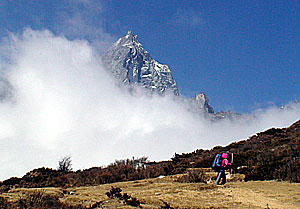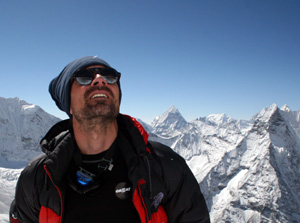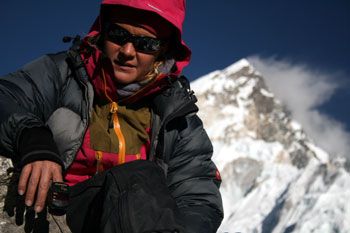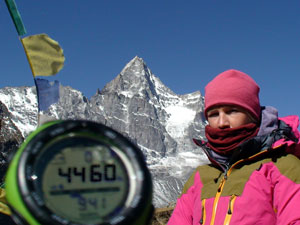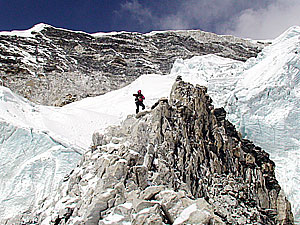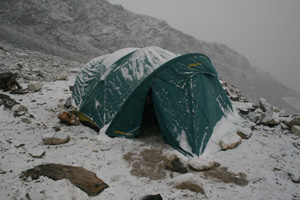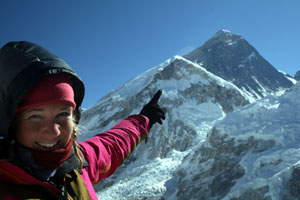 |
 |
Low on oxygen while getting high.
Can a freediver
sustain the hardships of low oxygen at altitude better
than normal people? Is there a training effect that will
effect your breath hold ability? As I planned to
climb as high as possible in the Himalayas I was hoping
to find this out. by: Sebastian
Naslund
Inexperienced
As freediver I
have experience of low oxygen. Having practiced maximum
static many times and suffering from unconsciousness
several times due to low oxygen. In several different
scientific tests I have ventured deep into hypoxia, as
low as 40-45% on a saturation meter.
| As a climber I am a novice, not having been higher than 1200 meters, not even owning proper trekking boots and actually loathing walking for the sake of just sightseeing. But the prospect of exploring the effects of heavy work at high altitude on my body was motivation enough. For the inheritance from my grandfather I bought a pair of custom made big fancy trekking boots. I borrowed my mothers high tech backpack and set of merrily to Nepal to meet freediver and climber Annelie Pompe. |
|
| 2800 - into
thin air From Kathmandu we flew to Lukla at 2800 meters height. Already when examining the map on the start of the first day I knew it would be a challenge – I realized I probably in my life never walked longer than 20 kilometres on a day, and never upwards, and never with a load. Now I was to carry some 20 kilos several thousand meters upwards. The higher you climb, the less oxygen in the air, or more alarmingly, less air pressure, which means the oxygen is not available, the partial pressure is not enough to get the O2 into your blood. Gas exchange is impaired. |
|
On the second day we found ourselves in famous Namche bazaar - a place where most Everest expeditions pass by. This village clings on to the mountainside at 3400 meters. A days rest was advised in the guide books.
4000 - risk
of altitude sickness
On the forth day
we aimed for a village called Dole at 4000 meters. It is
not advised to add 600 meters in a day. The last 200
meters up to Dole I felt like giving up, headache was
pounding, heart rate 130 although taking one deep hungry
breath every two steps. I was walking on the edge of
lactic acid all the time. First symptoms of altitude
sickness are: headache, fatigue, nausea, dizziness, lack
of coordination.
I had decided that as long as I recovered (breathing and heart rate) when resting I would accept having only one of the several symptoms of altitude sickness. Altitude sickness kills people as low as 3000 meters. Exercising at these levels with constantly low oxygen may give you both brain damage and lung oedema. The feeling in my head at 4000 was similar to a test I did in a lab where they let me breath only 14% and 17% oxygen (instead of the usual 21%). At height the brain swells, causing headache and nausea.
|
Measuring
oxygen levels In the
following days we added hundreds of meters every
day. Saturation of 75% constantly! This is a value that I have after 4 or 5 minutes of breath hold. |
|
Cho La pass
On day 8 we
crossed the famous Cho La pass at 5300 meters and that
was one of my life’s biggest physical challenges.
Breathing, breathing – one step, breathing, one step,
stop, look up, breath, one step, adjust the backpack.
Concentrating on finding footholds in the step rubble of
stones leading up to the pass and the glacier beyond.
At 5000 meters you have only access to 50% of the oxygen
normally found at sea level. How does the body react to
that? It tries to adapt. It is called acclimatization
and should be done at height without exercise, we where
pressing on every day though.
| The body has to
do something, otherwise there will be damage. The main
thing that happens is that the body starts building more
haemoglobin. Kidneys release hormones that trigger
production of red blood cells. These bonds to oxygen and
your oxygen uptake increases. Further up the kidneys
discard water to alter the bloods acidity. The body
expels more CO2, again disrupting PH balance of blood. I
am not a keen meet eater and to make haemoglobin you
need iron – did I have enough? Meter by meter, hour by hour, day by day |
|
At certain altitudes we checked saturation and heart rate after sitting down and resting for two minutes on the path. On none of these occasions did my heart rate go below 90 even though resting for two minutes. The saturation was generally around 80-85% after the short rest.
We also tested a few of the local sherpas that carried load up the mountains. They usually got the same saturation levels as us - but their heart rate was generally lower and returning faster closer to resting values.
We also did
breath holds
at different altitudes. In the mornings, after only 3-4
deep breaths. Above 3000 meter none of us managed breath
holds longer than 1.40. The lack of oxygen and general
exhaustion all days was not ultimate preparation. Also
the body starts producing more CO2 at height which we
felt in abnormally early and fierce contractions. Also
the hard exercise (and constant cold) every day probably
drove up the general metabolism. The onset of
bradycardia was swift. At 4400 I did a breath hold with
these characteristics:
|
|
At start: 80%
saturation, 70 heart rate. |
I discovered that I could reduce heart rate by 10% and increase saturation values by 5-8% by changing the way I breathed, using a modified yoga breathing that increased partial pressure (modified hook breathing). This usually gave me a headache, so I did not use it that much. Blood pressure usually soares at height, I measured mine at 4700 meters and got a value of 140/90.
| 6000 On day 14 we set out to climb a 6000 meter mountain. Higher than any peak in Australia, Africa or Europe. That night we camped at 5600 meter experiencing snowfall all night. My resting values in the tent that morning where 71% saturation and a heart rate of 85. If this was in a hospital, doctors and nurses would come running. That morning we started climbing in darkness, leaving backpacks behind, only carrying crampons, rope, ice axes and water. |
|
We reached 6000 meters feeling totally exhausted, experiencing a drunken feeling and a slow mind. After a 2 minute rest I again showed 70% in saturation and a heart rate of 95. That day we ascended 400 meters and then descended 1300 meters walking more or less constantly for 12 hours, most of it with heavy load. One of the most physical days of my life.
High altitude
training
A known effect of breathholding is the
contraction of the spleen - which releases its supply
red blood cells. Apnea scientist Erika Shagatay wonders
if this mechanism will be trained at high altitude and
thus be stronger/quicker at sea level. Recently it was
seen that spleen contraction occurs at altitude. Another
question is if high altitude training will make you more
tolerant to hypoxia - if you can functioning normal even
at low levels of stauration.
The effects of high altitude training is the forming of more red blood cells (haemoglobin) which both bind O2 and buffers CO2. But as Erika points out, there are negative effects of high altitude training. Higher risk of infections, loss of appetite, muscle reduction. The good effects some claim lasts 14 days, others say only three days.
|
|
Coming down to more human altitude levels I was keen to know if my oxygen levels and uptake would have benefited from the training and the acclimatisation. I was hoping to beat a 6.50 result done a month earlier after 10 days on meditation retreat. Due to general exhaustion and the throat infection I could not really tell if high altitude training had helped. Back in Namche my resting values where a few % better (notably) compared to when coming up. Heartrate slightly down and oxygen values sligthly up. <--One in then die if they try to climb up there. |
The effect of
high altitude training
One day
after the trek back in Katmandu at 1200 meters level I started doing
breath holds, but my metabolism seemed high for many
days, contractions coming 25% earlier than usual. I
was in a bad shape, infection with green snoot and
even some traces of blood. Also limping due to a dogbite. I was also semi numb in the top all fingers
for a week after coming down.
For the following ten days I held my breath every morning noticing no effect of any increase of red blood cells. During this time I loaded with c-vitamins and my infection showed signs of giving away. After a week I started eating some iron supplement (since I had not been eating meat for some time).
It was not until the 13th day after
the mountian back in Bangkok at sea level that I saw
some tiny signs of a altitude training effect. First day
in BKK was bad, but then the next day: Heart rate slowed
down below 60 in the morning, saturation went up from
95-96% up to 97-98%. A 25-30%
delay of contraction onset, but oxygen seemed to drop at
the same time as usual while breath holding.
Breath up of of 20-25 deep breaths during six minutes: contractions at 3.50 (earlier in the week always at 2.50). Saturation 90% at five minutes breath hold and heart rate of 50 at five minutes.
| A visit to the doctor on the 11th day showed a blood pressure of 110/70 (on the mountain 140/90) and haemoglobin values of 144 (usually 155). So no training effect? Why? 1) To little time at height? 2) Iron deficiency? 3) Delayed response? 4) HB count may have increased, but also plasmavolume, thus not higher concentration? Evaluation proceeds - this page will be updated... |
 |
17 days after coming down from spending 14 days above 4000 meters I returned to Sweden (sealevel). The oximeter directly showed 1-2% higher values. Resting at 98-99 (which is expected). Why had the Bangkok values also at sealevel been slightly lower all the time? Could it be polution? CO emissions (which there is plenty of) crowding out the bloods O2 stores.
A breathhold in Sweden showed same values as in Bangkok.
90% saturation at 5 minutes and a heartrate of 51.
23 days after coming down from the mountain
92-93% saturation at 5 minutes (based on value at 5.20 due to the "slowness" of the meter). Continuing to 6.30 having a heart arte of 41 and a lowest saturation 86%.
Is this the first signs of a high altitude training effect?
24 days after the mountain
86% saturation at 5 minutes (lowest value). Heartrate 53.
25 days after the mountain
90% and 51 heartrate after 5 minutes
26 days after the mountain
88% and 48 heartrate after 5 minutes
| All values from doctors bloodtest 11 days after spending 14 days above 4000 meters. HB 14,4 HCT 44 WBC 7.300 PMN 68 LYMP 26 MONO 6 PIT SMEAR: ADEQUATE RBC MORFO: NORMAL RBC COUNT 4.95 PlT COUNT 304.000 Lying down (>15 min) reduces HB value with about ten. |
Older sealevel values: 1) Hematokrit HCT: 45% rise to 48% after maxapnea (probably due to spleenrelease). 2) 2006/2007: 3) 2006 3) 2003/2004 |

